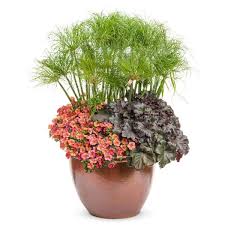Prince Tut Grass, also known as Cyperus alternifolius ‘Prince Tut,’ is a type of plant that looks like a mini palm tree. It’s a special kind of grass that can grow in wet areas, like near ponds or in containers filled with water. People really like Prince Tut Grass because it adds a unique and exotic touch to gardens and landscapes.
This grass has long, thin stems that shoot up from the base, and at the top of each stem, there’s a cluster of leaves that looks like an umbrella. These leaves are green and kind of feathery, which gives the plant a soft and graceful appearance. The stems can grow quite tall, usually about 2 to 3 feet, and they bend a little bit, making the plant look elegant and swaying in the wind.
One of the great things about Prince Tut Grass is that it’s not very difficult to take care of. It loves to be in a sunny spot, so placing it where it can get a good amount of sunlight is important. Also, since it likes wet places, you need to make sure it doesn’t dry out. Keeping the soil or the container it’s in consistently damp is the key to keeping this grass happy.
If you’re growing Prince Tut Grass in a pot, it’s a good idea to use a container without holes at the bottom, so water doesn’t drain out too quickly. You can even put the pot in a shallow dish filled with water to keep the soil moist. However, if you’re planting it in a garden, make sure the area has good drainage to prevent water from pooling around the roots.
During the growing season, which is usually spring and summer, you can give the grass a bit of liquid fertilizer every month or so to help it grow nicely. And if the grass starts to get a bit too tall for your liking, you can trim it down a bit to keep it looking neat and tidy.
Prince Tut Grass is not just a plant, it’s like a little piece of a tropical paradise that you can bring into your own space. Its unique appearance and easy care make it a popular choice for people who want to add a touch of the exotic to their gardens or patios. So, whether you’re a gardening pro or just starting out, Prince Tut Grass could be the perfect addition to your outdoor oasis.
Read Also: Cutworms: How to Identify and Get Rid of Cutworms
Growing and Care Guide of Prince Tut Grass

Below are the growing and caring for Prince Tut Grass:
1. Choosing the Right Spot: Select a sunny location for your Prince Tut Grass. It loves sunlight and will grow best in a spot that receives at least 6 hours of direct sunlight each day.
2. Soil Preparation: Use well-draining soil for planting Prince Tut Grass. If you’re growing it in a pot, make sure the container has drainage holes to prevent water from pooling.
3. Watering: Prince Tut Grass thrives in wet conditions. Keep the soil consistently moist but not waterlogged. If you’re growing it in a container, consider placing the pot in a shallow dish with water to maintain a constant moisture level.
4. Fertilizing: During the growing season (spring and summer), you can feed your Prince Tut Grass with a diluted liquid fertilizer every 4 to 6 weeks. This will help promote healthy growth and vibrant foliage.
5. Pruning: If the grass grows too tall and starts to look untidy, you can trim it back. Use clean, sharp pruning shears to snip away the taller stems. This will encourage new growth and keep the plant looking neat.
6. Overwintering: In colder climates, Prince Tut Grass may not survive the winter outdoors. If you’re growing it as an annual, you can simply enjoy it during the warm months and replant next year. If you want to try overwintering it, you can bring the potted grass indoors and place it in a sunny window. Reduce watering during the dormant period.
7. Pest and Disease Control: Prince Tut Grass is generally resistant to pests and diseases. However, keep an eye out for common garden pests like aphids or mealybugs. If you notice any issues, treat them promptly with insecticidal soap.
8. Propagation: You can propagate Prince Tut Grass by dividing mature plants. Gently remove the plant from its container, divide the root ball into smaller sections, and replant each section in its own container or space in the garden.
9. Container Care: If you’re growing Prince Tut Grass in a pot, make sure the container is large enough to accommodate its growth. Choose a pot with good drainage and use a soil mix suitable for aquatic plants.
10. Landscaping: Prince Tut Grass is often used to add a tropical or exotic touch to gardens and landscapes. You can plant it near water features, in damp areas, or even in large containers placed strategically around your outdoor space.
Remember that while Prince Tut Grass is relatively easy to care for, each plant’s needs may vary slightly. Regular observation of your plant’s health and adjusting care accordingly will ensure its successful growth and a lovely addition to your outdoor environment.
Benefits and Uses of Prince Tut Grass

Below are the benefits and uses of Prince Tut Grass:
1. Aesthetic Appeal: Prince Tut Grass adds a touch of elegance and exotic beauty to gardens, landscapes, and outdoor spaces. Its graceful, umbrella-like leaves and swaying stems create a unique visual appeal.
2. Water Filtration: This grass is excellent for water gardens and aquatic environments. Its roots help filter and purify water, improving the water quality and creating a healthier habitat for aquatic life.
3. Erosion Control: Planted along the edges of ponds, lakes, or streams, Prince Tut Grass helps prevent soil erosion by stabilizing the banks with its root system.
4. Natural Privacy Screen: When planted in groups, the tall stems of Prince Tut Grass can act as a natural privacy screen, providing a subtle barrier and enhancing the sense of seclusion in outdoor spaces.
5. Wildlife Habitat: The grass offers a nesting and sheltering place for birds, insects, and other small wildlife, contributing to the overall biodiversity of your garden.
6. Educational Tool: Prince Tut Grass can be used as an educational tool to teach children about aquatic ecosystems, plant growth, and the importance of wetland conservation.
7. Cut Flower Arrangements: The feathery foliage of Prince Tut Grass makes it an attractive addition to cut flower arrangements, adding texture and movement to bouquets.
8. Container Gardening: Due to its adaptability to water-filled containers, Prince Tut Grass can be grown in decorative pots, adding a touch of nature to patios, balconies, and indoor spaces.
9. Water Feature Enhancement: Placing Prince Tut Grass around water features like fountains or ponds enhances the visual appeal of these elements, creating a harmonious and serene ambiance.
10. Landscape Focal Points: This grass can serve as a focal point in landscape designs, drawing attention to specific areas of your garden and creating a more visually interesting setting.
11. Therapeutic Spaces: The presence of Prince Tut Grass in outdoor spaces can have a calming and soothing effect, providing a peaceful environment for relaxation and meditation.
12. Temporary Installations: Because of its adaptability, Prince Tut Grass can be used in temporary installations for events, weddings, or seasonal decorations.
Incorporating Prince Tut Grass into your outdoor environment can offer a range of benefits beyond its aesthetic appeal. Whether you’re looking to improve water quality, attract wildlife, or create a unique landscape feature, this versatile grass can serve a variety of purposes in different settings.
Read Also: Effect of Tropical Climate on Animal Parasites, Vectors and Diseases
Where to Find Prince Tut Grass near Me/You

Here are three perfect places to find or locate Prince Tut Grass:
1. Water Gardens or Ponds: Prince Tut Grass is particularly well-suited for water gardens or ponds. Its love for wet conditions makes it an ideal choice to be placed at the edges of water features. The grass not only adds visual interest but also contributes to water filtration and provides shelter for aquatic life.
2. Outdoor Containers and Planters: If you’re looking to add a touch of elegance to your patio, balcony, or outdoor living area, Prince Tut Grass can thrive in containers filled with water. Placing these containers strategically can create a visually appealing and unique focal point, bringing a bit of the exotic to your space.
3. Landscapes with Sunlight: Prince Tut Grass thrives in sunny locations. Consider incorporating it into your landscape design in areas that receive ample sunlight throughout the day. Whether it’s lining a pathway, framing a garden bed, or serving as a backdrop for other plants, the graceful appearance of this grass can enhance the overall aesthetic of your garden.
Remember that the suitability of these locations may vary based on your specific climate and local conditions. Proper care and attention to the grass’s water needs will help ensure its successful growth in these chosen spots.
Read Also: Characteristics and Marketing Strategies for Consumer and Industrial Products
